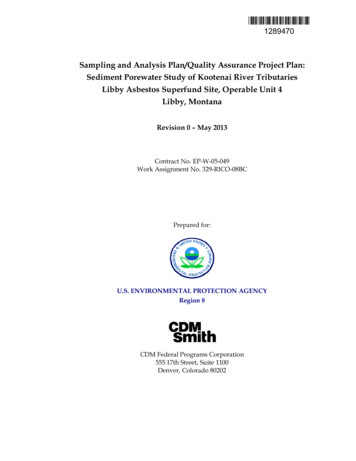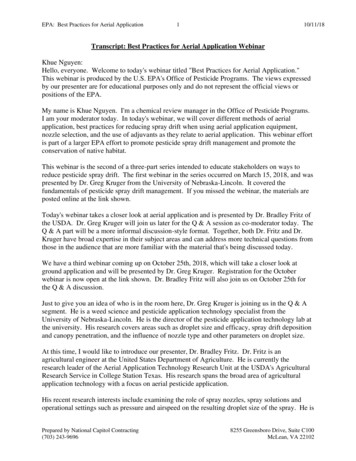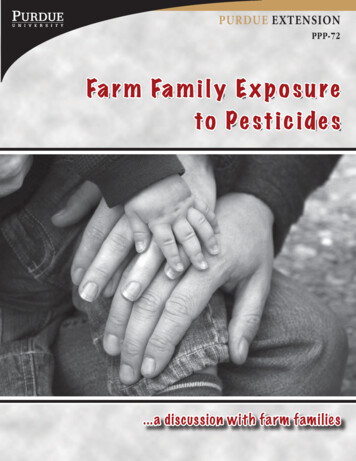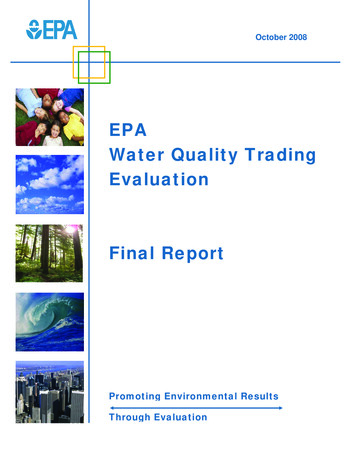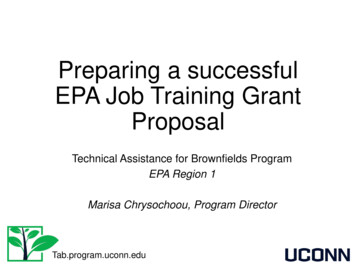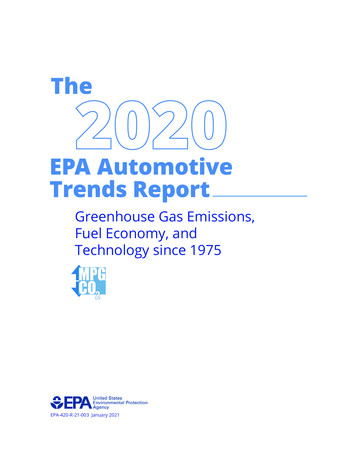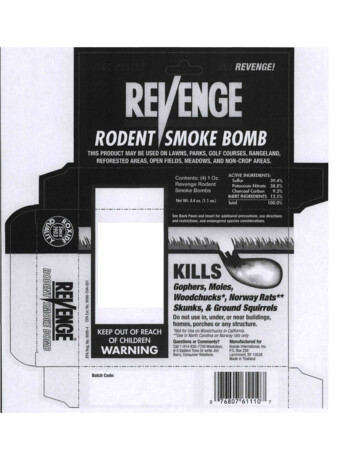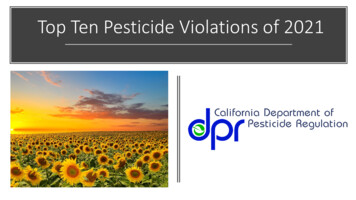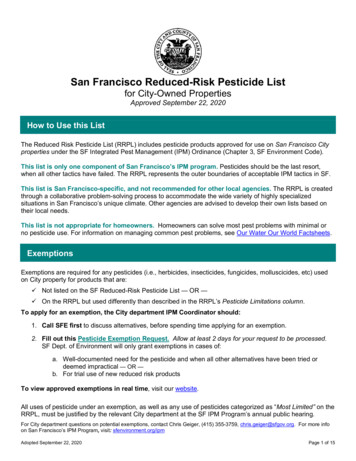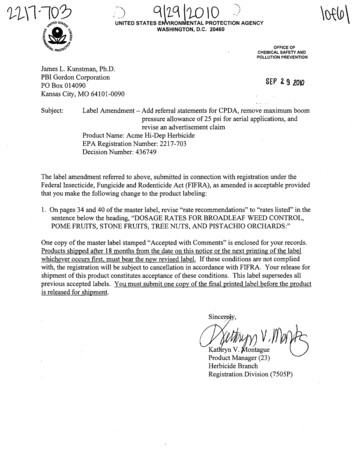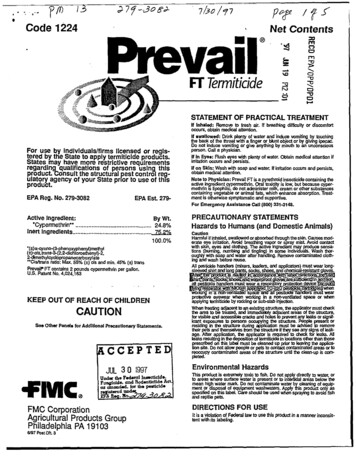
Transcription
.-.13Code 1224Net Contents:tl ",MoIT1 "oFT -" o""0o.STATEMENT OF PRACTICAL TREATMENTFor u:se by Individuals/firms licensed or registered by tile State to apply termltlclde products.State 1 may have more restrictive requirementsregarding qualifications of persons using thisproduct. Q)nsult the structural pest control regulatory agency of your State prior to use of thfsproduct.EPA R.eg. No. 279-3082EPA Est. 279-Active Ingredient:By Wt.*Cypermethrin** . . . . 24.8%Inert Ingredients. 75.2%100.0%'( )a:C)',IJ1Oo(3-phenoxyphenYl)methYi( )-cis,/r.tns- .(2,2-dlc1ilo",elh6nyl)· ,2.amethylcyclopropanecarboxylate"Cis/lrans ratio: Max. 55% ( ) cis and min. 45% ( ) transPrevail" I'T contains 2 pounds cypennethrin per gallon.U.S. Patent No. 4,024,163If Inhaled: Remove ID fresh air. If breathing difficulty or discomfort rs, obtain mecflCa! attention.If swallowed: Drink plenty of water and inooc:e vomiting by lDuchingthe back of the throat with a finger or blunt object or by giVIng ipecac.00 not induce vomiting or give anything by mouth to an unconsciousperson. Call a physician.If In Eye.: Flush eyes with plenty of water. Obtain macflCa! attention ifirritation occurs and persists.If on Skin: Wash with soap and water. If irritation occurs and persists,obtain medical attention.Note to Physician: Prevail FT is a pyrethroid insecticide containing theactive ingredient cypennethrin. Oral IDxicity Is low, but because cyper·methon IS lipophilic. do not administer milk. cream or other substancescontaining vegetable or animal fats, which enhance absorption. Treat·ment is otherwise symplDmatic and supportive.For Emergency Assistance Call (800) 331-3148.PRECAUTIONARY STATEMENTSHazards to Humans (and Domestic Animals)CautionHannful if inhaled, swallowed or absorbed through the skin. causes mod·erate eye Irritation. Avoid breathing vapor or spray mist Avoid contactwith skin, eyes and dothing. The active Ingredient may produce sensations (burning, numbing and ting6ng) In some Individuals. Wash thor·oughly with soap and water after handUng. Remove contaminated ciolfi.Ing and wash before reuse.and awt1cators)KEEP OUT OF REACH OF CHILDRENCAUTIONSee I'ther Panel. for Additional PrecauUonary Statements.CCEPTEDJUL 30 :997FMC CorporationAgricultural Products GroupPhiladelphia PA 19103Gl97 Peat Oft. 3When treating acfJ8C9l1lID an existirlg slrudlJre, the applicatOr must checkthe area ID be traated, and lmme fl8te1y adjacent areas of the sIrudIJre,for visible and accessible cracks and holes to pr.ant any leaks or slgniIIoant exposures ID persons occupying the stnJctUre. People present orresiding In the slrudlJre during lCation must be advised to removeIheir pets and themselves from the slrudlJre Hthey see any signs of teak·age. After application, the applicalor Is required ID check for leaks. AUleaks rElSlJlting in the deposltion of tenniticid8 in locations other than those",ascribed on this label must be cleaned up prior ID IeaVfng the appf1C3tion site. Do not allow people or pets ID contact contaminated areas or IDreoccupy contaminated areas of the structure unlll the clean-up Is c0mpleted.Environmental HazardsThis product Is extrllll1ely toxic ID fish. Do not apply dlrecliy ID water, orto areas where surface water is present or to intertidal areas below themean high water mark. Do not contaminate water by cleaning of equipment or disposal of eqUipment washwaters. Apply ihls product onlY asspecifiad on this label. care should be used when spraymg ID avokf fishand reptile pets.DIRECTIONS FOR USEIt is a violation of Federal law to use this proooct in a manner inconsis·tent with its iabe.ng.
·.SUBTERRANEAk "ERMITE CONTROLSTORAGE: AND DISPOSALDirections For UsePesticide SI g.Do not store below 40' F. Keep oul 01 reach of children. Slere inoriginal conlain "" only. SIDra in a cool, dry P'- and avoidexCas&heal carefuliY Open oonlainers. Aller parti'aI use, replacelids end dose lightly. Do nol put concentrate or dilute material inlefood or drink OOi1lainers. 00 nol contaminate other pesticides, 1eI'tirlZ. walei', food or feed by slorage or disposal.In case of spil, avoid contacI. Isolate area and keep oUi animalsand ,"""olected persons. Confine spills. Call FMC (600) 331-It is a vlolaticn of Federal law to use this product In a manner inconsislent with its label.Important: Contaminalion of public: and private water suppltes must beavoided by following these precaullons: Use ami-backlloW eqUipment orprocedures 10 prevent siphonage of insectioide Into water supplies. Donot contaminate cisterns or wells. Do not treat soil that is water saturated or tozen. Do net treat while precipitation is occurring. Consull staleand local see ffic:allons for recommended distances of wells from treatedareas, or If such regulations do not exls reler to Federal HousingAdminls ation SpecifiCations (H.U.D.) lor guidance.Not.: Craw;spaces are to be considered Inside of the structure.Critical Ar.: Critical areas Include areas where !he foundaticn is peI1:etrated by Utility serviceS, cracks and expansion joinls, bath traps andareas where cement constructions have been poured adjacent to thefoundation such as stairs, patios and slab additions.3148-To confine spil: If liquid, dike surrounding area or absorb withsand, cal fitter, oommarc:iaJ day or gel absOrbenls. If dry material,cover '" prevanl dlspersal Place damaged package in a holdingoon . ldentilyoonlenls.P.stIcId. DlspcalPesl! :ide wastaS.alexIc. Improper diSposal of excess pesticide,spmy miXlllre, C rinsate Is a VIOlation of Federal laW. If lhasewastes cannot te dlsoosed 01 by use according Ie label Instruolions, oonract your rare PestiCide or Environmental ConlroiAgency, or the liazardous Waste representative of !he neareslEPA Aajlional Office lor guidance.Coma/nor DI"P',.IMetal Conlaine.,,: Triple rinse (or equivalenl). Then offer for re :jcling or recondllkming, or puncllJre and dispose 01 in a sanilar)'iandfiI. or by ether prooadures approved by state and localauIhOOlies.Plastic Contain s: Triple rinse (or equivalent). Then offer lorre :jcing or reccnditioning, or puncllJre and dispose of in a sanI-ntary """'liD, or incineration, or, allowed by state and lcoalauthorities, by burning. II burned, stay oUi of smoke.Glass Conlainerl: Triple rinse (or equivalent). Then dispose 01 ina sanitary landfill or by other approved state and lcoal procedures.Re efiilable Sealed Containe.: Do net rinse conlainer.Do not empty re:naining formulated product. Do not break seals.Reun intad to "oint of purchase.Generallnforll1tatlon on the Use of This ProductThe use of this product prevenls and oon ols termite infestations in andarotMld slrUCtUres and constrUctions.The dilulo insecticidal emulsion musl be adequately dispersed in !he soilto estabish a banief between the wood and the termites in the soil. As agood practfce: 1) "U non-essential wood and cellulose containing materials sh *f be rema;ed tom around foUndation walls, aawl spaces, andporches: 2) elimina/E, termite aooess to moisture by repairing faulty plumb'"9 and/or construction grade. Soil an Und un eated structural wood inconlact wiIh soil shoold be treated as clescilbed below.To eslablish an effective Insecticidal barrier with this product the servicemust be t.mlliar with aJtTenl termite conlroi practices such as: enchlng. redding, sub-slab injecllon, coarse fan spraying of soil surfaces, ciad and crovlce (void) injection, excavated soil !Iea andbrush or spray appfio:a1lonS to infeSted or susoepbble wood. These technIQues must be correotiy employed to prevent or oon oI Infestations bysubterranean temlltes such as: Cop/owrmes, HetefOtsrmes,ReticuiJetmes and Zootarmopsis. The biology and behavior of thespecies k1VoIved shc: lld be corisIdered by !he senrice technldan in determining wIich oontrol praoIioes to use to ellminale or prevent the termiteinfestation.Choice r:I appropria'le prooadures should Indude consideration 01 suchvariable !actOrs as Ute design of the strUctu"" location of heating, ventilation. and air condIticning (HVAC\ systems, water table, soli type, soilcompadlon, grade c OnClltlOris, and location and type of domestio watersupplies and Ublities.For advice concami,g currenl oon oI practices with relation to specificlocal conditions, consull resources In structural pest oon oI and statecooperalYe extensiC 1 and regulatory agendas.StrUcture. with WeilaiClotoma Inolde foundaUon.Struotures thai oontain weDs or cisterns within the foundation 01 a struetu'" can only be treated using the following techniques:1. Do not treat so while it is beneath or within the Ioundation or alkmgthe exterior rimeter of a structure that contains a well or cistern. Thetreated backfill melltod must be used if soil is removed and trealedoutside/away from the loundation. The treated backliD technique isdescribed as follows:.a Trench and "'move soli to be treated onlD heavy plastio sheetingor similar material or into a wheelbarrow.b. Trnat the soli at !he rate of 4 gallons of dilute emulsion per 10 6near feet per foot of depth ollhe trench, or 1 gallon per 1.0 cubicleet 01 soil. See "Mixing Directions section of the label. Mix thoroughly into lite soli taking care to contain the liquid and praventrunoH or spillage.c. After the ated soil has absorbed !he diluted emuls.lon, replacethe soil into !he nch.2. Treat inlested and/or damaged wood in place using an inleotion technique such as described in !he "ConlrOl of Wood InlesbnQ Insects".section of litis label.Structures with Adjacent Wells/Cisterns andlor Other Water BodIe Applicators must inspect all structures with nearby water sources suchas waDs, cisterns, surface ponds, streams, and other bodies of waterand evaluate. at a minimum, the treatment recommendations listedbelow prior to making an application,. Prior to atment, if feasible, expose !he water plpe(s) coming fromthe well to the structure, if !he pipets) enter lhe struoturn within 3 lestof grade.2. Prior to atmen applicators are advised to taka precautions to limitthe risk of applying the termiticlde into subsurface drains lItat couldempty into any bodies of water. These precautions indude evaluatingwhelfler application of the tenniticide to the top of lite footer may",suit in oontaminaticn of the subsurface drain. Factors such as deplflto the drain system and soill)'P.S and degree of compaction should betakan inle account in detennlning the depth of e n t3. When apPfOP.riate 0.9., on lite water side 01 the s11UctUre), )h!I \RIatedbackfill technoque (described above) can also be used ID monlmlZe offsite movemenl of termiticide.Prior to using this technique near wells 0( cisterns, consult state, focalor federal agencies for infonnation regarding approved treatmenl practices in your area.Application Ral.:'Use a 0.25 % emulsion lor subterranean tennites. For other pesIs on !helabel use specific listed rates.Mixing Dlroctions: Mix !he lerrniticide use dilution in the IoUowIng manner: FlU tank 1/4 to 113 fun. Start pump to begin by-pass agitation andplace end of ng IDOl in tank to allow circulation through hose. Addappropriate amount of Prevail" FT termiticidellnsectioide. Add remainingamount of water. lat pump run and allow recirculaticn thn ugh the hosefor 2 to 3 minutes.PrevaH" FT may also be mixed into run tanks of wal/lr, I:lut requires substantial agilatlon to insure uniformity 01 the emulsion.To prepare a 0.25% water emulsion, ready ID use, dilute t gallon of Pre"""FT" with 96 gallons of water.Mixing:For the desired awlicatlon rate, use the chart below to del8nnine theamount of Prevail"'FT lor a given volume of finished emulsion:1224 sm Pasl 011.3
3Pre-Constru .AmountPr.constructlon Treatment: Do not apply at. lower dosage and/orconcentraUon than specilled on this label for applications prlo toAmountDulAd Gallcuof RIIsbld Emulliol.IP.nFT1.33 oz.6.67 oz.13.33 oz.0.250.51.02.0afWllor126.67 oz.19.8 qt:s.9.923.7547.5961920.5%·2.B7oz.13.3302.26.57 oz.0.51.02.04.0125.33 oz.19.6 qts.9.S23.5479519015102'48971941.0%·5.33 oz.26.67 oz.53.3 oz.1.02.04.0S.O122.67 oz.15102448971940.25.,.sAmoum of PrevaI,(Gallons except wham '4897194Common 'nltl of mouunl:1 pin!:.16fluldounc:M(Oz.)1 ;don . "" quarts . 8 pIntS . 128 fluid OUI"IC8I; (oz.)"For tannlta applications, only usa these rates in conjunction with theappHcation volume adjusttnents as listed in the section below or in theloam or underground service application sections.AppllcaUon Volume: 10 provide maximum control and protactionagainst tarmita infestation apply the specified volume 01 the finishedwater emulsion and active ingrecient as set forth in the directions for usesection "f this label. If soil wiU not accept the labeled applk,ation volume,!he volume "!ay be reduced provided there. is a corresponding inaease'" conc ltra1JOn so that the amount of aclive ingredient appITed to thesoil remains the same.Note: La.rge reductions of application volume reduce the ability to obtaina contin:JOus barrier. Variance is allowed when volume and concentration are l::onsistent with label directed rates and a continuous barrier ca.nstill be achieved.Where desirable for pre and post construction trealments, the volume ofthe 0.5 % emulsion may be reduced by ;:, the labeled volume or a 1.0 %emulsion may be applied at '/4 the labeled volume (see VolUmeAcljustmOllt Cnart). Volume adjustments at 1.0% are not recommendedfor subslab Injection. See Volume AdjUSlme lt Chart below.NOlo: When volume is reduced, the hole spacing for subslab injectionand soIl.rodding may require similar adjustment to account for lower volume dispersal of the tarmltlcide In the so .Volume Adjustment ChartRata (% emulsion)0.25%0.5%1.0%VoIume I ow . d : Horizontal (gallonsemulsionl1o ft.')1.0 gaITon0.5 gallons 0.25 gallons"Vertical (galloosemulsio.ri710 lin. ft.)4.0 galions2.0 gallons 1.0 gallons""Not reoJmmended for subslab injection.Aft.rTrc'atm .I:AII holes In commonly occupied areas into which PrevaJlFT has teen applied must be plugged'. Plugs must be of a non-cellulosematerial or COllared by an ImpalVious, non-cellulose matarial.In Subterranean Tennlte Treatmentthe InatallaUon of the IInlshed grade.When treating founclations deeper than 4 fee apply the tarmiticide asthe backfii is being replaced, or if the construction contraclor fails tonotify the applicator to permk this, treal the foundation to a minimundapth of 4 feel af1er the bad fiU has been installed. The apprlCator musltrench and rod into the tra lch or trench along the foundation waDs andaround piUars and other founclation elements, at the rata presonbed frnmgrade to a minimum depth of 4 feet When the top of the footing isexposed, the applicator must treat the soil adjacent to the footing to adapth not to exCeed the bottom of the footing. However, in no caseshould a strudum be treaied below the footing.Effeolive pre-ccnstruction subJerranean tannite control is achieved bythe establishment 01 vertical and/or horizontal insecticidal barriersusing 0.250/0 emulsion of Prevail" FT. To meet tarmita proofing requ.ments, follow the procedums in the latast edition of the Housing andUrban Development Minimum Property Standards (refer to U.S.DAHome and Garden Bulletin No. 64).Horizontal Barriers: Creata a horizontal barrier wherever treated SOHwill be covered bY. concrete, such as footing trenches, slab floors. carports, and the sod beneath stairs and crawl spacesTo produce a horizontal insecticidal barrier, apply the emulsion altherata 01 1 gallon par 10 square feet to fill soil. If fill is washed gravel orolher coarse material, apply at 1.5 gallons of emulsion per 10 SC\U8f8feet so that the emulsion will reach the soil beneath the fill. AppflCalionsshall be made by a low pressure spray (less than 50 p.S.l.) using acoarse spray nozzle. If slab will not be poured the same day as trea}moot, cover treated soil with a water--proof barrier such as poJyethyJenesheeting. This is not necessary if foundation walls have bilen insialledaround the treaied soil.Vertical Barriers: Vertical barriers should be established in areas suchas around the base of foundations, Iumbing, utility entrances, backfilled soil againsl foundation walls and other critical areas.To produce a vertical barrier in soil, applY the emulsion at a rate of 4gallons par 10 linear feet per foot of depth. Distributa the treatment asevenly as possible.a When redding or trenching. it is important that emulsion reachesthe top of the footing. Rod holes should be spaced to provide acontinuous insecticidal barrier.b. Care should be taken to avoid soil wash-out around the footing.c. Trenches need not be wider than 6 Inches. Emulsion should bemixed with the soil as it is being replaced in the trench.d. For a monolithic slab, an inside vertical barrier may not berequired.Hollow block voids may be treated at a rata of 2 gallons of emulsion per10 linear feet so that the emulsion will reach the top of the footing.Prior to each application, applicators must notify the general contractor,construction superintanden or similar responsible party, of the intended tarmiticide application and intanded sites of application and instnJctthe responsible person to notily construction worl ers and other individuals to leave the area to be treaied during application and until the tar miticide is absorbed into the soil.Post-Construction Soil TreatmentUse a 0.25% emulsion for posl-construction treatment Post-construction soil approcations shall be made by injection, rociding, ancllor tre lching or coarse fan spray with pressures not e""""ding 25 p. .i. althenozzle. Care should be taken to avoid so wash-out around the fooling.Do not apply emulsion untilio :ation of weHs, radiant heat pipes, walerand sewer lines and electrical conduits are known and identified.Caution must be taken to avoid punclLlring and injection into these elements.Foundations: For applications made after the IinaI grade Is Installed. !heapplicator must trench and rod info the trench or trench along the f0undation walls and around pillars and olher lounclalion elements, at the rateprescribed from grade to the top 0/ the footing. When the boting is morethan lou' (4) feet beiow grade, lIle appIicalC( must trench and rod into thetrench or trench along the founclation walls at the rata prescribed to a minimum depth of four feet The actual depth 01 treatment will vary cIepending on soil type, degree of compaction, and location of farmita actiVity.When the top 01 the footing is exposed, the applicator must treat the sciadjacent to the footing to a depth not to eXceed the bottom of the boling.However, in no casa should a structure be trealad below !he footing.Slabs: Vertical barriers may be established by sub-slab injection within the struclLlre and rociding ancllor trenching outside at the rate of 4gallons of emulsion per 10 linear feet par foot of depth. Special caremust be taken to diSlnbute !he treatment evenly. Treatment should notextOlld below the bottom of the footing.1224 6197 Post Dft.3
,"Tniat along !he outside of !he foundation and where n, 0SS!'f beneaththe slab on !he inside of foundation walls, Treatment may also befe :\Uired eath the slab along both sides of interior-suppor1ed walls,one side 01 intericf partitions and along all cracI s and expansion joints.Horizontal barriers may be eslablished where necessary by Iong-rodding or by. grid pattern ,njection vertically through !he slab.a DriI holes in the slab and/or foundation to allow for the app6cationof a continuclus insecticidal barrier.b. Fe( shallow foundations (1 foot or less) dig a narrow trenchapproxima o/ 6 inches wide along the outside of !he foundationwals. Do not dig below the bottom of !he footing. The emulsionshould be applied to !he trench and soil 814 gaRons per 10 linaarleaf: per foot of depth as the soi is ",placed in the trench.c. For foundatk ns deeper than 1 foot follow rates for basementd Exposed soil in bath traps may be treated with a 0.25% emulsion.Ba ls: Wh"", !he footing Is Qreater than 1 foot of depth fnlmgrade ID !he bollOm of the foundabon, appfication can be made bytrenching an llor r dding at the rate of 4 gallons of emulsion per 10 linear loot per foot "f depth. Sub-slab Injection may be necessary aIonathe inside of foundation wailS, along cracks and partition walls, arounCIpipes. c:ooduits, piers, and along both sides of interior fooling-supportedwals.Accn.1bIe Crawi Spaces: For crawlspacas, vertical tennit!cidebarriers al1he rate' of 4 gallons of emulsion per 10 linear feet per root ofdepth from grade to !he top of the footing, or if !he footing is mora than 4foot below grade, 110 a minimum depth of 4 fool Apply by trenching androddOlg into !he trooch. or trenching. Treat both sides of foundation andaround' aI piers an pipes. Where pnysical obstructions such as concretewaII Ways adjaceni to foundation elements prevent trenching. treatmentmay be mad9 by redding alone. When soil type and/or oonditions maket r prohibitive, redding may be used. When !he top of !he footing ise1he applicator must treat the soil adjacent to !he looting to adepIh not to exceed !he bottom of 1he footing. Read and follow !he mixingand use diraction section of !he label If situations are enoounterad where!he soil wi not accapt !he full application volume1. Rod holes and tcencl1es must not extend below !he bottom of theloo ing.2. Rod holes must be spaced so as to achieve a continuous tenniticidebUt In no case mora than 12 inches apart3. Trenches must be a minimum of 6 inches deep or to !he bottom of !he whichever is less, and need not be wider than 6 Inches. WhenIr9I1ding in sloj:ing (tiered) soil, !he trench must be stepped to ensureadeQuate distributiOri and to prevent termiticlde fnlm running of. Theemulsion must te mixed with !he soil as it is replaced in the trench.4. When treating plenums or crawl spaces, tum off !he air circulation system of !he slrUclure until applicatiOn has been completed and all 1eI'miticide has been absorbed by !he soil.Ino lo Cra.' Space.: For Inaccessible interior areas, such asareas where there is insufficient clearance between floor joists and groundsurtaces ID allow operator access, excavale ff pcsslble, and treat according to fie Instruc1lcins for accessible crawl spaces. Otherwise, apply oneor a oombir1aIion of !he following two methods.1. To ISh a ho rizonlal barrier, apply to !he soil surtace, 1 gallon ofemulsion per 10 square foot overaJi Using a nozzle pressure of less1Ial2S p. .!. an a coarse application nozzle (e.g., Delavan]Ype RDRaindrop. RD-7 ,or larger, or Spraying Systems Co. 8010lP TeeJeI or no.,""). For an area tf1at cannot be reached with !he 8JlPIi'caOOn wand, I.IS" one or more extension rods to make !he appflcationID !he soil. Do nelt broadcast or powerspray with higher pressures.2. To 8&labIish a t Orizonlal . dnll through !he loundation wall orthrtltIgh 1he 1Ioor above and treat !he son perimeter at a rate of 1 gallonof aniIIsIon per , 0 square fool DriD spacmg must be at inle VaIs 001 toexceed 161nc:he . Many S1ates have smaller inle VaIs. so check StateregWIions which may apply.When 1I8aling plenums and crawl spaces, tum of !he air circulation system of fie structum' until application has been completed a'Id all tennilicide has been abscrbed by the soil.Masonry Volda: Drill and treal voids In multiple masonry elements of !hestruc:!Llu extending from !he sllUCtum to !he soil in order to creale a c0ntinuous - . . t bMier in !he area b be Ireaied. Apply at !he rate of 2gallons of emusion per 10 linear feet 01 looting, using a nozzle pressure01 less 1m 25 p.sl. When using this 1I'eatmen access holes must bedrilled below !he sill plate and shOuld be as close as possible to !he Ioo Ing as is practical. Treatment of voids in block or rubble foundation wallsmust be closely examined: Applicators must Inspect areas of possiblerunoff as a precauton against appficalioo leakage in !he Ireated areas.Some areas may n,t be trealablEi or may requite mechanical alterationpriorlD tAI IeaI s resulting In !he deoosition of termitidde In locations other thanthose puscrlbed orl this Iabei must be cleaned up prior to leaving theappIicalcn site. Do not allow people or pets to contact contamiriatedareas or b recxx:upy !he contaminated areas of !he structure unlil the Is oomplebid.Nole: When treating beh;'. d099r care should be ial en not to drillbeyond !he veneer. 11 concrete biocl s are behind the veneer, both !heblocks and !he veneer may be drilled and trealed at the sam. time.excavation Technique: If treatment must be made in difficult situations , along fieldstone or rubble walls, along faulty foundation walls,and around pipes and utirl!y lines which lead CIownward fnlm 1he structure to a well or pond, application may be made In the following man-ner:a Trench and remove son to be treated onto heavy plastic sheetingor similar material.b. Treat the soil at the rate of 4 gallons of emulsion per 10 linear teetper loot of depth of the trench. MiX the emulsion thoroughly inlDthe soa lal ing care to prtlvent liquid from running off the finer.c. After !he Ireated soil has absorbed the liquid emUlsion, raplace !hesoil in !he trench.FOAM APPLICATIONSPravall" FT tennicide emulsion, fnlm 0.25% to 1.0% may be convertedto a foam with 9 sion characteristic from 2 to 20 times and the foamused to treat voids to control or prevent tennite, an bee or waspinfestations.localized AppllcaUonFoam AppllcaUona: The emulsion may be con"",rIed to a foam and !hefoam used to control or prevent tennite infestations.Dependirlg on !he circumstances foam applications m be used aloneor ,n comtiination with liquid emulsion appllCalions. Ap ,caIions may bemade behind veneers, piers, chimnay bases, into ru bIe foundaUons,into bIocI voids or structural voids, uilder slabs, stoops, porches, or tothe soil in crawlspaces, and other sim ar vom.Foam and liquid application must be consistent with volume and activeingradient instructions in order to insura'propEl!' application has beenmade. The volume and amount of active mgr9cient ara essential to aneffective treatmenl At least 75% of the labeled rlCjuid emulsion volumeof product must be applied. with !he remaining PElrcenl deliverad toeppro areas using foam apprlCation. Reter to label and use recommendations of the foam manufacturer and the foaming equipmentmanufacturer.Foam apprlCations are generally a good supplement to liquid treatmentsin difficult areas, but may be used ,",one in difficult spots.Application Under Slabs or to SoU In Crawlspaces:Ap licationmust be made using Prevail- FT foam in combination withliquid emulsion appfications. At least 75% of the labeled liquid emulsionvolume of tenniade must be applied.Sand Barrier Instanatlon and TreatmentTermiles can bund mud tubes ovar treated surfaces as long as theyhave access 10 untreated soil and do oot have 10 move Prevan- FTtreated son. Fill in cracks and spaces with builder's or play box sandand treat !he sand with Preval FT. The sand should be treated as soifollowing the tenniticide rate fisted on !he Prevru;- FT label.Re eatrnent for subterranean termites can ally be performed ff there isdear evidence of refnfestation or disruption 01 the bairIer due to construe tion, excavation, or landscapiflg and/or evidence of !he breakdown of !hetarmit!cide barrier in !he soil. Thiese vulnerable ot ra/nfested areas may beretreated in ance with appflCStion i8cIv1iques desctlbed in thisprod""'s labeling. The timing and type 01 these retreatments wiU varydepencfmg on factors such as tennile pressura, soil types, SOIl oondillooSand other factots which may reduce !he e"ectiveness of the barrier.Annual rat",.tmont of tho structur. Is prohlbHod unlo. tho", I.cI r evldoncethat rolnfestatlon or berri. dIsrUption ha. occurrodAPPUCATlON IN CONJUNCTION WITH THE USE OFFIRSTUNE TERMITE BAITSAs of !he integrated pest management (IPM) program forc0ntrol, Prevail FT may be appf'19d to critical areas of !he structure includingplumbing and utiliI)' entry sites, bath traps, expansion joints, foundationCracks and areas with l nown or suspectSd VlIeS'IaIions at a rate a 0.25%as a spot treatment or complete barrier trealment Appilcalloos may bemade as described in !he PoslCOnstruclioo trealment section of this 1iIbeI.SPECIFIC PEST CONTROL APPLICATIONSUNDERGROUND SERVICES such as: winls, cables, utility fines,pipes, conduits, etc. Services may be within structures or located outside structuras, in right-of-ways or to protect long range (miles) 01installations of services.Soij treatment may be made using 0.25 to 0.5% Prevail" FT emulsionto p",venl attac:k by tennites and ants.122451117 Post Dft.3
Apply 2 gallons of emulsion per 10 6ne. .J.t to the bottom 01 thetrench and allow to soak into the soil. lay services on the treated soiland oover with approximalaly 2 inches 01 fin soil. Apply another 2 gallons pef 10 linear feet over ihe soil surface to oomplete the treatmentbarrier. In wide trenches, only treat the soK in the area near the ser,vices. It is important to establish a oontinuous barrier of trealed soil sur-rounding the services.-When. soil will not accept the above IabaIed volume, 1 gallon of 0.5%Pre""il" FT may be used per 10 6near feet 01 trench both to the bottom01 the trench and over the soi on top of the servioes.Finisl1 fining the trenoh with treated fin soli. The soil where eaoh serviceprotrudes !rom the ground may be trealed by ing/nodding of nomore then 1 to 2 gallons of emulsion into the soli.Precautions:Concentration01 ActivePestsAntsBitin es-tBoxBu.1l&Centipedes (Clean-cut)Elm Leal greciant.1%DilutionFlare11: ", oz.per 1 galwaterPiU SSiiv shSowbugs.20/.1 fl,oZ.per 1 gal.water Do ""t treat electricall
Note to Physician: Prevail FT is a pyrethroid insecticide containing the active ingredient cypennethrin. Oral IDxicity Is low, but because cyper· methon IS lipophilic. do not administer milk. cream or other substances containing vegetable or animal fats, which enhance absorption. Treat· ment is otherwise symplDmatic and supportive.
